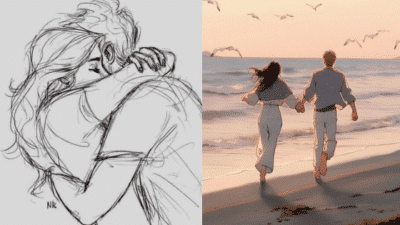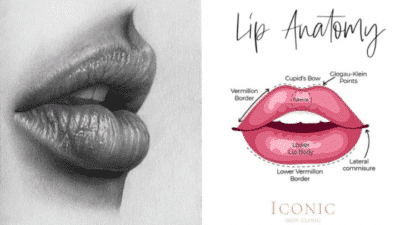Drawing poses is an essential skill for any artist looking to create dynamic, lifelike figures. Whether you’re sketching characters for illustration, designing concept art, or practicing figure drawing, understanding how to capture natural and expressive poses can transform your artwork from static to captivating. By mastering the art of drawing poses, you can bring depth and emotion to your characters while improving your overall artistic abilities.
Tools like Quickposes, SketchDaily Reference, and JustSketchMe have revolutionized how artists practice pose drawing. These online resources provide extensive libraries of reference images and 3D models that allow you to study human anatomy from any angle. You can filter poses by style, props, gender, and more to find exactly what you need for your current project.
Regular practice with varied poses helps develop your visual library and improves your ability to draw from imagination. The key is consistency – even short daily sessions focusing on gesture drawing can significantly enhance your understanding of weight distribution, balance, and natural movement in the human figure.
Key Takeaways
- Regular practice with diverse reference materials is crucial for developing your ability to draw convincing and dynamic poses.
- Online tools like Quickposes and JustSketchMe offer customizable reference options that can be tailored to your specific artistic needs.
- Understanding the fundamentals of human anatomy and movement will help you create more expressive and natural-looking figures in your artwork.

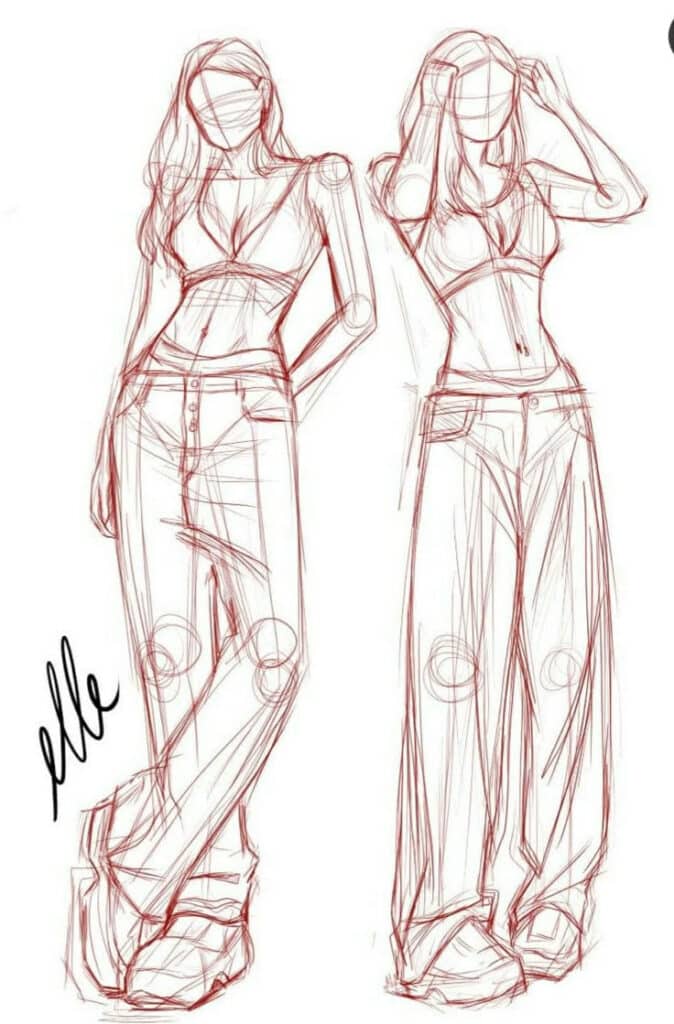
Fundamentals Of Drawing Poses
Drawing dynamic and realistic poses requires a strong foundation in several key areas. Mastering anatomy, proportions, and gesture techniques will transform your figure drawings from stiff to expressive and lifelike.
Understanding Basic Anatomy
Knowledge of anatomy forms the backbone of effective pose drawing. You don’t need to memorize every muscle, but understanding major muscle groups and skeletal landmarks is essential.
Focus on the ribcage, pelvis, and spine as your primary structural elements. These three components create the core movement in any pose. The ribcage houses vital organs while providing attachment points for shoulder muscles. The pelvis anchors the legs and supports the upper body.
Joints dictate how limbs can move realistically. Study the limitations of shoulders, elbows, knees, and ankles. This prevents you from drawing impossible poses that break the viewer’s immersion.
Remember that muscles have specific shapes when relaxed, contracted, or stretched. This knowledge helps you create tension and weight in your drawings.
Establishing Proportions
Proper proportions transform a basic sketch into a believable figure. The average adult human body is typically measured in “heads” (the height of the head), with most figures spanning 7-8 heads tall.
Use simple ratios to quickly establish proportions:
- The shoulder width equals approximately 2-3 head widths
- Arms reach mid-thigh when hanging naturally
- The elbow aligns with the bottom of the ribcage
- Hands extend to mid-thigh
Begin with a simple stick figure or line of action before adding volume. This approach prevents distorted proportions that often occur when starting with details.
Create measurement guidelines before detailing. Map the relationship between body parts using horizontal and vertical lines to maintain consistency throughout your drawing.
Gesture Drawing Techniques
Gesture drawing captures the energy and movement of a pose in seconds. This technique emphasizes flow over detail, focusing on the essence of the pose rather than perfect anatomy.
Start with quick, fluid lines that establish the line of action—a single curved line representing the figure’s spine and overall movement. This creates an immediate sense of dynamism in your pose.
Use C-curves and S-curves to suggest weight distribution and balance. These sweeping lines represent how the body naturally curves when in motion or supporting weight.
Practice timed gesture drawings daily (30 seconds to 2 minutes per pose). This builds your visual library and trains your eye to quickly identify the core elements of any pose.
Remember that exaggeration often reads better than strict realism. Don’t be afraid to push the pose by emphasizing the angles and curves that make it interesting.

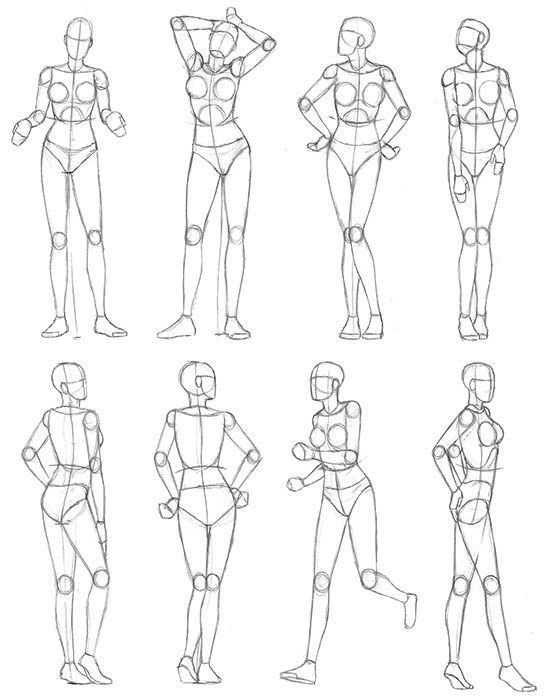
Mastering Dynamic And Expressive Poses
Dynamic poses breathe life into artwork, transforming static figures into compelling visual stories. Mastering these poses requires understanding motion, body language, and spatial relationships that create depth in your drawings.
Creating Fluid Motion In Art
The key to dynamic poses lies in capturing movement through the line of action. This imaginary line runs through the figure’s spine and establishes the flow of energy. When drawing, sketch this line first to guide the pose’s direction and momentum.
Avoid symmetrical poses as they appear static. Instead, create contrast with weight distribution—if one hip is high, lower the opposite shoulder. This counterbalance mimics natural human movement and adds authenticity.
Study dancers and athletes to understand how bodies move during action. Their exaggerated postures reveal how weight shifts and muscles engage. Try quick gesture drawings (30-60 seconds) to capture the essence of motion without overthinking details.
Anime models often utilize exaggerated lines of action to convey powerful emotions and movements. Notice how these stylized figures bend and twist beyond realistic limits while still maintaining a sense of believability.
Depicting Powerful Body Language
Body language communicates emotion and intention before any facial expression registers. Strong poses establish character and narrative through subtle positioning of limbs and torso.
Consider what your figure is feeling—confidence shows in an open chest and squared shoulders, while fear appears in a protective, hunched posture. Your character’s emotional state should inform every aspect of their pose.
Use contrapposto (where weight rests primarily on one leg) to create natural, relaxed stances. This classical technique instantly adds credibility to standing figures by introducing subtle asymmetry.
Bold directional poses convey purpose and determination. When a character reaches, lunges, or strides with clear intent, viewers experience a sense of wonder and engagement with your art.


Capturing Depth And Perspective
Foreshortening creates dramatic depth by showing parts of the figure projecting toward or away from the viewer. Practice drawing limbs that appear to extend from the page by compressing their proportions according to perspective rules.
Work with multiple vanishing points to position figures convincingly in three-dimensional space. Understanding how forms recede creates more immersive compositions and prevents floating figures.
Overlap body parts to reinforce spatial relationships—an arm crossing the torso, a hand partially obscuring the face. These visual cues help viewers understand which elements are closer to them.
Use varying line weight to enhance depth—heavier lines for foreground elements and lighter ones for areas farther away. This technique, common in both traditional and digital art, subtly reinforces the illusion of three-dimensional space.

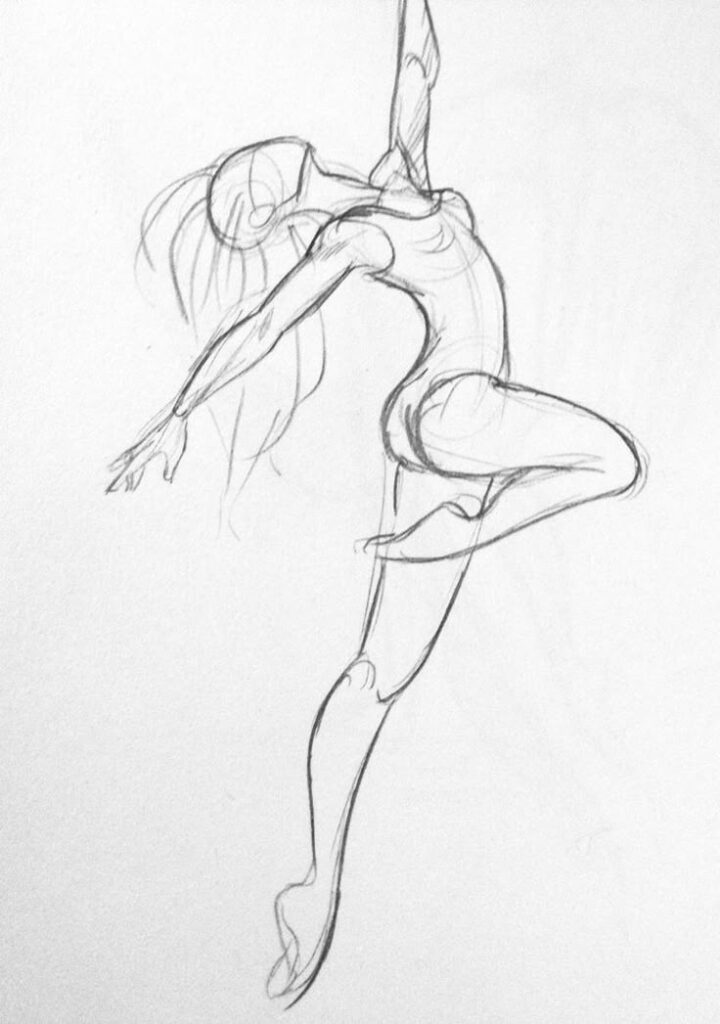
Effective Tools And Resources For Pose Drawing
Finding quality reference material is crucial for mastering figure drawing. Artists today have access to numerous digital and physical resources specifically designed to help practice different poses and improve drawing skills.
Using Pose Reference Libraries
Reference libraries provide organized collections of poses that help artists study human anatomy and movement. Line of Action offers timed practice sessions that challenge you to capture poses quickly, improving your gesture drawing abilities. The timer feature helps develop speed and accuracy—essential skills for professional artists.
Sketch Daily is another excellent resource that includes a customizable timer. You can select how long you want to spend on each reference image, from quick 30-second gestures to more detailed 10-minute studies.
Many libraries categorize poses by type, making it easier to find specific references. You can practice dynamic action poses, subtle standing positions, or seated figures based on what you need to improve.
Pose Reference Photos And Videos
High-quality reference photos provide detailed visual information for accurate drawings. Websites like Quickposes offer extensive image libraries with various models in different lighting conditions.
Videos can be even more valuable than static images when studying movement. They allow you to observe how weight shifts and muscles engage during action sequences.
Some artists create their reference photos using smartphones or digital cameras. This approach gives you complete control over lighting, angle, and pose specifics.
Consider investing in pose reference books that contain professional photography specifically designed for artists. These often include annotated images highlighting important anatomical landmarks.
Digital Tools: Apps And Websites
Modern artists benefit from specialized digital tools created for pose practice. Posemy.art lets you manipulate 3D models in any position, providing references from any angle without needing a live model.
JustSketch.me offers a free character posing tool that allows you to adjust lighting conditions, helping you understand how shadows fall across the human form. You can save custom poses for future reference.
SetPose.com provides realistic figure references with adjustable lighting options. The interface is intuitive, making it easy to find exactly what you need.
Many of these digital tools offer both free and premium versions. Free versions typically provide enough features for beginners, while paid options unlock additional models, poses, and customization options.
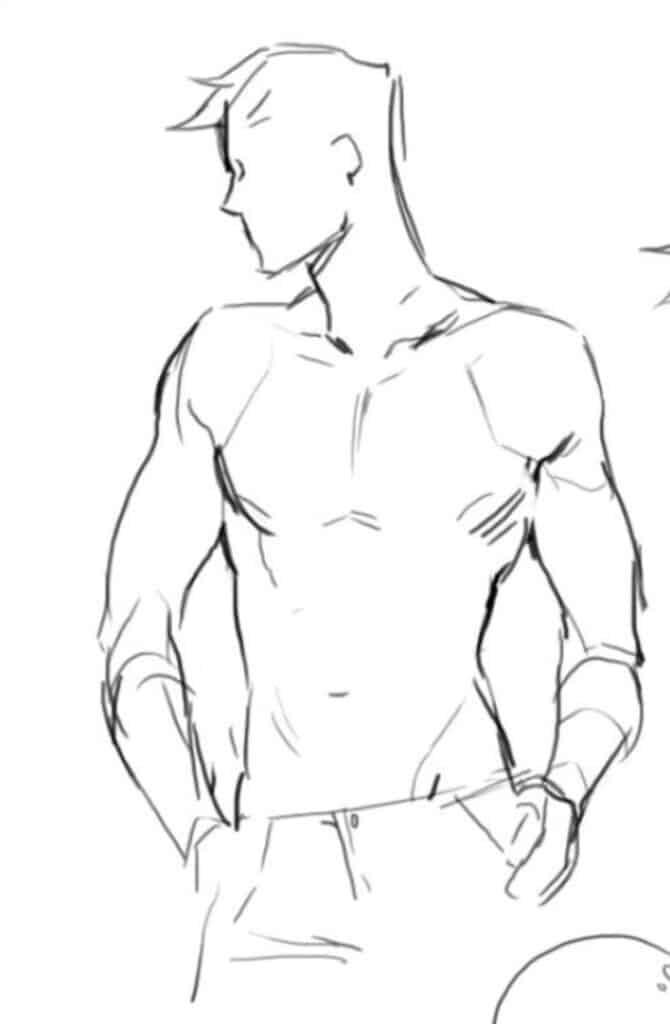

Practicing And Improving Drawing Poses
Developing your pose drawing skills requires regular practice and specific techniques that target common challenges. The right approach can dramatically accelerate your progress and help you create more dynamic, realistic figures.
Timed Practice For Skill Development
Timed practice is one of the most effective ways to improve your pose drawing abilities. Start with gesture drawings using 30-second to 2-minute intervals to capture the essence of a pose quickly. This forces you to identify the key lines of action without getting lost in details.
As you progress, extend your practice time to 5-10 minutes for more refined studies. Websites like Quickposes provide libraries of reference images specifically designed for timed practice sessions.
Create a consistent schedule—even 15 minutes daily yields better results than occasional long sessions. Track your progress by keeping your early sketches to compare with newer work.
The pressure of time constraints helps you develop intuitive understanding of proportions and movement, making it easier to eventually draw poses from imagination.
Overcoming Common Drawing Challenges
Many aspiring artists struggle with similar pose-drawing obstacles. One frequent issue is proportion errors, which can be addressed by using the “head count” method—measuring the figure as units of head lengths.
Stiffness in your drawings often results from focusing too much on outlines. Instead, sketch the line of action first—a single curve that captures the pose’s energy and flow.
Reference photos can be both helpful and limiting. While they provide accurate information, overreliance may hamper your ability to draw from imagination.
To develop this skill, practice “constructing” figures using simple shapes before adding details. This approach builds your understanding of how the body works in 3D space.
For challenging angles and foreshortening, break down the pose into basic geometric forms. This simplification makes complex perspectives more manageable.
Incorporating Props And Scene Elements
Adding props and environmental elements to your pose drawings creates context and enhances storytelling. A figure interacting with objects feels more grounded and purposeful than one floating in empty space.
Start by practicing simple props that complement your figures—chairs, books, or everyday items. These objects provide natural reasons for specific poses and can help you understand how weight distribution works.
Consider how props affect a pose’s balance. A character carrying a heavy bag will shift their weight to compensate, creating more dynamic lines.
Scene elements also provide valuable practice for perspective. When your figure stands on ground planes or interacts with architectural elements, their positioning must follow consistent spatial rules.
Try creating thumbnail compositions where figures interact with their environment. This develops your skill at integrating poses into complete visual narratives while maintaining natural proportions and relationships.


Exploring Style, Creativity, And Application
Style and creativity are what transform basic figure drawings into expressive artworks. Your personal approach to poses, textures, and presentation can set your work apart in both artistic and commercial contexts.
Simple Versus Complex Poses
Simple poses offer an excellent starting point for developing your figure drawing skills. Begin with basic standing or seated positions that emphasize clear silhouettes and balanced weight distribution. These fundamental poses help you master proportions and anatomy without overwhelming details.
As your confidence grows, challenge yourself with more dynamic poses. Experiment with twisting torsos, foreshortening, and action positions that convey movement or emotion. Remember that complex doesn’t always mean better – sometimes a simple pose with perfect execution creates more impact than a complicated one.
Try the “gesture-to-detail” approach: sketch the basic flow of the figure in 30 seconds, then gradually add complexity in layers. This method prevents you from getting lost in details before establishing the pose’s energy.
Exercise tip: Set a timer and draw the same pose at different time intervals – 30 seconds, 2 minutes, and 5 minutes – to practice capturing essentials first.
Applying Textures And Painting Techniques
Texture adds dimension and character to your figure drawings. Start with basic shading techniques using hatching, cross-hatching, or stippling to create depth and form. These foundations work well in both traditional sketching and digital art.
When transitioning to paint, consider how different mediums interact with your drawing style. Watercolors create soft, translucent effects perfect for delicate figure studies, while acrylics or oils allow for more textural experimentation through impasto techniques or palette knife application.
Digital artists can leverage custom brushes that simulate various textures—from rough charcoal to smooth ink. Many illustration programs offer texture overlays that instantly transform flat drawings into richly detailed artworks.
Quick technique tip: Layer different media for unique effects. Try ink outlines with watercolor washes, or graphite sketches with digital color overlays.
Selling And Showcasing Your Art
Converting your figure drawings into sellable art requires strategic presentation and marketing. Create cohesive series rather than scattered individual pieces to establish a recognizable style that collectors can identify.
Online platforms like Etsy, Society6, and Instagram provide accessible entry points for selling art. Each platform serves different audiences—Etsy works well for original pieces, while print-on-demand sites allow you to offer affordable reproductions without inventory concerns.
Consider your presentation carefully. Professional photography of your work is essential, as is consistent branding across platforms. For figure drawings specifically, categorize your work appropriately to reach the right audience.
Pricing strategy: Start by calculating materials + time + skill level, then research similar artists’ pricing. Begin modestly and increase prices gradually as you build a following and improve your techniques.
- 1.5Kshares
- Facebook0
- Pinterest1.5K
- Twitter0
- Reddit0


